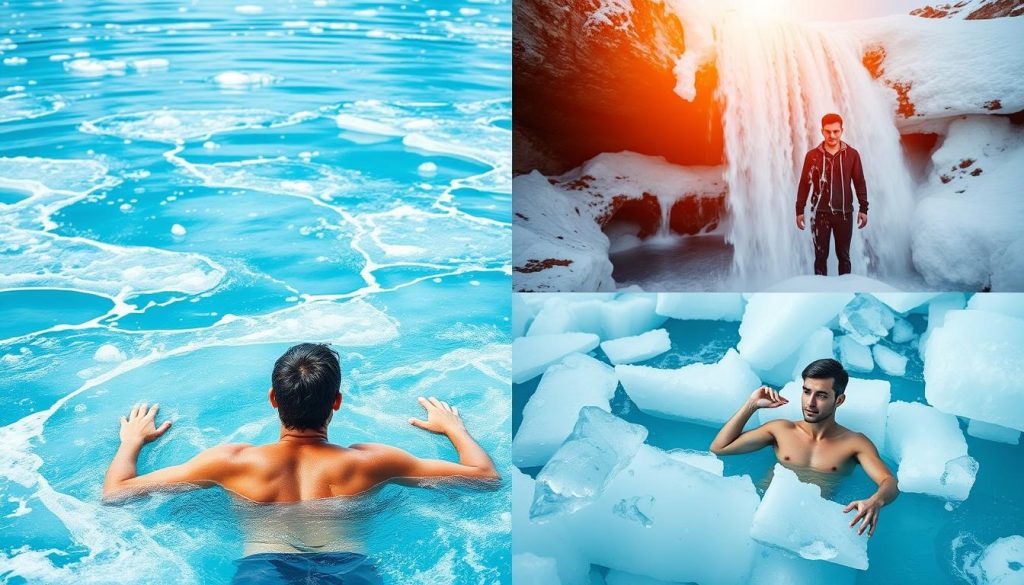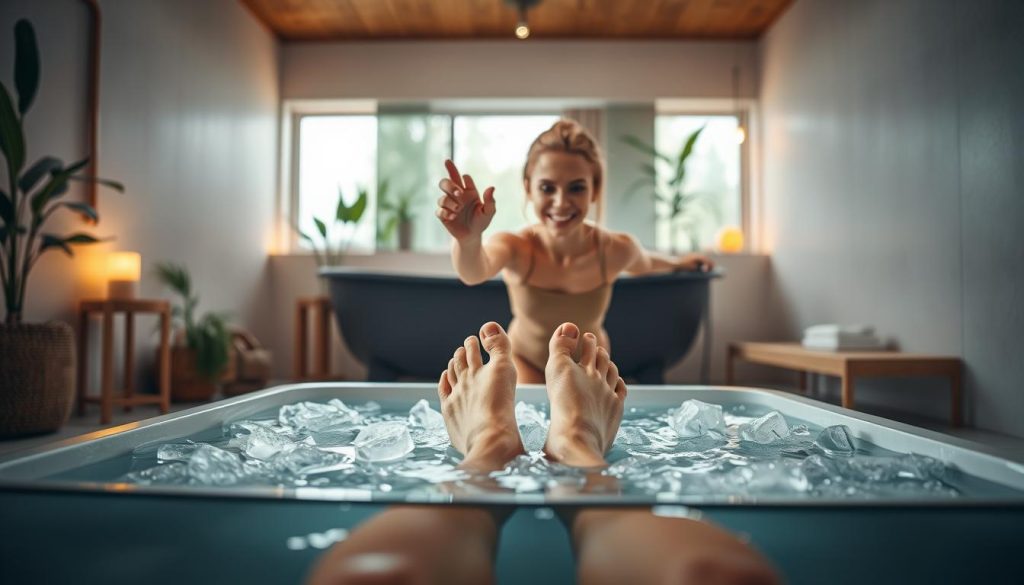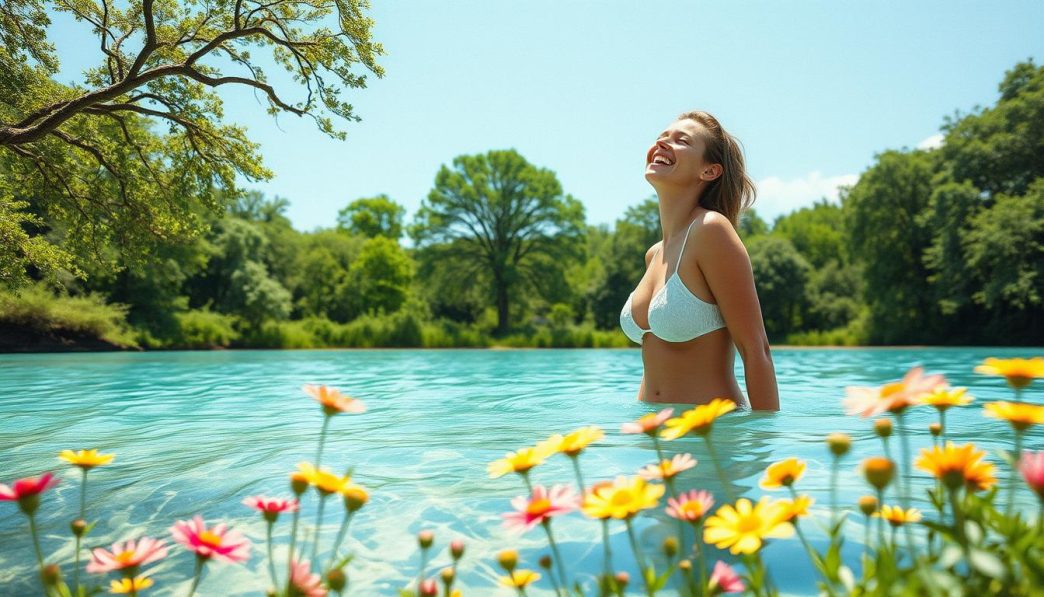As summer heats up, many are eager to discover effective ways to enhance their physical and mental recovery. Cold water therapy, also referred to as cold hydrotherapy, has emerged as a popular solution for rejuvenation in the warm months. This technique, which includes practices like ice baths and contrast showers, offers a plethora of benefits—from reducing muscle soreness to boosting the immune system and even improving mental health. With its growing appeal, cold water therapy provides an accessible means to refresh both body and mind, making it an excellent addition to your summer recovery routine.
Key Takeaways
- Cold water therapy promotes effective summer recovery.
- Ice baths and contrast showers are popular methods.
- This technique can reduce muscle soreness and boost the immune system.
- Cold water therapy also has notable mental health benefits.
- It is an easy addition to any post-workout routine.
What Is Cold Water Therapy?
Cold water therapy, often referred to as cold hydrotherapy, involves exposing the body to low temperatures for health benefits. This practice dates back to ancient civilizations, which recognized its potential to support physical and mental health. The definition of cold water therapy encompasses various methods, such as ice baths, cold showers, and natural cold plunges. Each approach serves as a form of recovery technique aimed at enhancing overall wellness.
Engaging in cold hydrotherapy can bring about considerable relief, particularly for athletes and active individuals seeking effective recovery techniques after intense physical activity. By immersing the body in cold water, benefits such as reduced muscle soreness, improved circulation, and stress management are achieved. Many people dealing with conditions like arthritis or chronic muscle pain find that this therapy offers an effective means of alleviating their symptoms.
Benefits of Cold Water Therapy
Engaging in cold water therapy can lead to various physical benefits that significantly enhance overall health and well-being. This practice has gained popularity among athletes and health enthusiasts due to its positive effects on muscle recovery, the immune system, and circulation. Below, we explore three major benefits that cold water therapy offers.
Reduced Muscle Soreness
The process of immersing the body in cold water aids in lessening muscle soreness after strenuous activities. Cold temperatures constrict blood vessels, which helps reduce blood flow to areas that have been worked hard. This action decreases inflammation, allowing for improved muscle recovery and a faster return to regular activity levels.
Immune System Boost
Taking regular cold water baths can enhance the immune system’s functionality. Exposure to cold encourages the body to produce more white blood cells, which play a crucial role in defending against illnesses. The increase in these vital cells effectively strengthens the overall immune response, promoting better health.
Improved Circulation
Cold water therapy also showcases impressive circulation benefits. When the body is submerged in cold water, it undergoes a cycle of vasoconstriction followed by vasodilation after exiting the cold. This not only enhances blood circulation but also aids in flushing out toxins and delivering essential nutrients to muscles. As a result, individuals can experience a more efficient muscle recovery process.
Cold Water Therapy: Ice Baths and Contrast Showers for Summer Recovery
Using ice baths and contrast showers during the hot summer months can significantly enhance recovery after intense workouts. Ice baths involve immersing the body in cold water, typically between 50°F-59°F, which aids in alleviating muscle soreness and speeding up the recovery process. This method is especially beneficial after strenuous physical activity, helping to minimize inflammation and reduce the lasting impact of fatigue.
On the other hand, contrast showers alternate between hot and cold water, creating a dynamic effect that stimulates circulation. This technique not only helps relax muscles but also refreshes the body, providing a revitalizing experience during the summer heat. Implementing these two methods into summer recovery strategies offers an effective approach to maintaining physical well-being.
| Cold Water Therapy Method | Benefits | Best Practices |
|---|---|---|
| Ice Baths | Reduces muscle soreness, decreases inflammation | Immerse for 10-15 minutes |
| Contrast Showers | Improves circulation, relaxes muscles | Alternate water temperatures for 10 minutes |
How Cold Water Therapy Works
Understanding how cold water therapy works involves exploring the physiological responses triggered by cold exposure. This therapy is not just about braving frigid temperatures; it offers significant benefits for recovery and overall health.
Vasoconstriction and Vasodilation
When the body is subjected to cold temperatures, vasoconstriction occurs. This process tightens blood vessels, directing blood away from the skin and extremities toward the body’s core. As a result, vital organs maintain warmth and functionality. Once a person warms back up, the body responds with vasodilation. This mechanism expands blood vessels, allowing increased blood flow to the extremities. This enhanced circulation aids in delivering essential nutrients and oxygen, which are crucial for muscle recovery and overall wellness.
Release of Cold Shock Proteins
Cold exposure stimulates the body to release cold shock proteins. These proteins play an important role in cellular repair and inflammation reduction. By mitigating inflammation, cold shock proteins assist in speeding up muscle recovery after intense exercise. They also help protect tissues from potential damage, making them a vital component in the effectiveness of cold water therapy.
Ice Bath Temperature for Maximum Benefits
For anyone looking to maximize the benefits of cold water exposure, understanding the optimal ice bath temperature is crucial. Research indicates that water temperatures ranging from 50°F to 59°F (10°C to 15°C) can significantly enhance recovery. Immersing the body in this temperature range for approximately 2-4 minutes offers several advantages.
The benefits of cold water exposure include improved muscle recovery and heightened levels of dopamine, which contribute to enhanced mood and focus. Staying within this ideal temperature range helps to mitigate the risks of hypothermia while allowing for effective physiological responses.
Incorporating the optimal ice bath temperature into your recovery routine can lead to more profound wellness effects, promoting not just physical recovery but mental health benefits as well.
Different Methods to Experience Cold Water Therapy
Cold water therapy offers various methods to suit individual preferences and access levels. Each approach provides unique advantages, making it easier for anyone to incorporate this recovery practice into their routine.
Ice Baths
Ice baths stand out as one of the most recognizable methods of cold water therapy. Athletes often utilize this technique for full-body immersion in icy water, significantly aiding in recovery. This method helps reduce inflammation, alleviate muscle soreness, and speed up the healing process after intense workouts.
Cold Showers
Cold showers present a convenient method to experience the benefits of cold water therapy from the comfort of home. Starting with a warm shower and gradually switching to cold allows for an energizing experience. This transition not only boosts alertness and vitality but also enhances mood through increased endorphin levels.
Outdoor Swimming
Outdoor cold water immersion in natural bodies of water offers a refreshing escape, especially during the summer months. Swimming in colder temperatures invigorates the body, enhances mood, and provides a sense of connection with nature. While this method is enjoyable, participants should approach outdoor swimming with caution to ensure safety in unpredictable environments.

Is Cold Water Therapy Safe for Everyone?
The safety of cold water therapy is a common concern for many considering this practice. This method can be safe when performed correctly and in controlled settings such as ice baths or cold showers. Individuals should be aware of potential contraindications that might affect their ability to participate in cold water therapy.
People with underlying health conditions, such as circulatory disorders, high blood pressure, or cardiovascular diseases, must consult healthcare professionals before beginning. Proper guidance can help minimize risks associated with cold exposure.
Extreme exposure without adequate acclimatization may leads to complications, including hypothermia or cardiovascular strain. Awareness about the safety of cold water therapy helps in making informed decisions, ensuring individuals can safely enjoy its numerous benefits.
| Condition | Consultation Needed | Risk Factors |
|---|---|---|
| Circulatory Disorders | Yes | Increased strain on circulation |
| High Blood Pressure | Yes | Potential for elevated blood pressure responses |
| Cardiovascular Diseases | Yes | Risk of heart stress and related issues |
| No Known Health Issues | No | Generally safe with proper protocols |
Mental Health Benefits of Cold Water Therapy
Cold water therapy offers not only physical recovery but also notable mental health benefits. Exposure to cold can significantly alter the brain’s chemistry, leading to improved mood and a reduction in stress levels.
Dopamine Production
Cold water immersion triggers a remarkable increase in dopamine levels, with studies showing a boost of up to 250%. This surge in dopamine contributes to enhanced mood and motivation, promoting an overall sense of well-being. By regularly engaging in cold water therapy, individuals may experience better mental clarity alongside increased energy levels.
Anxiety Reduction
Many find that the invigorating rush of cold water leads to significant anxiety relief. This experience can serve as a natural antidote to daily stress factors, providing a refreshing escape. The combination of increased dopamine and the stark sensations of cold water can transform negative thoughts into positive feelings, thus making cold water therapy an effective strategy for managing anxiety.
How to Start Cold Water Therapy at Home
Starting cold water therapy at home opens doors to refreshing experiences that can enhance recovery and well-being. Engaging in at-home cold showers and ice baths for beginners can be both easy and rewarding. Understanding how to gradually incorporate these techniques is essential for building comfort and maximizing benefits.
Taking Cold Showers
For those looking to begin with at-home cold showers, a gradual approach works best. Start with warm water, then slowly lower the temperature until reaching a comfortable cold level. Initially, keep the exposure time short, gradually increasing it as your body adapts to the sensation. Consistent practice can improve tolerance and make the experience more enjoyable.
Adding Ice Baths to Your Routine
Incorporating ice baths for beginners can be an exhilarating way to experience cold water therapy. Begin with just a few seconds of full immersion. As you become accustomed to the cold, you can gradually extend the duration. Focus on staying comfortable during this process, exploring the positive effects of cold exposure on recovery and relaxation.

Safety Tips for Cold Water Therapy
Engaging in cold water therapy can be highly beneficial, yet it is crucial to prioritize cold water therapy safety to prevent any adverse effects. Start your journey with brief exposures. This allows your body to acclimate and reduces the risk of hypothermia. After each session, it is essential to warm up your body gradually. Sudden changes in temperature can strain the body, so ensure a smooth transition back to your regular body temperature.
When trying cold exposure for the first time, consider having a companion. This is especially important if you are using natural cold water sources such as lakes or rivers. A responsible partner can ensure your safety during the process.
If you have underlying health conditions, consult with a healthcare provider before beginning cold water therapy. Discussing cold exposure will clarify whether it is suitable for your individual health circumstances.
Combining Cold Water Therapy with Other Recovery Techniques
To maximize the benefits of cold water therapy, it is essential to integrate it with various complementary recovery techniques. Stretching and massage can significantly enhance flexibility while relieving muscle tightness, making them ideal partners with cold water applications. Proper hydration has a vital role in recovery, supporting optimal muscle function and sustaining energy levels throughout your day.
Stretching and Massage
Incorporating stretching into your routine offers numerous benefits, particularly when performed after cold water therapy sessions. Stretching promotes blood flow and aids muscle recovery, enhancing the body’s ability to bounce back post-exercise. Massage techniques can further alleviate muscle soreness, contributing to overall relaxation and well-being.
Hydration and Nutrition
The importance of hydration cannot be overstated. Water intake is crucial for recovery, as it helps flush out toxins and maintains electrolyte balance. When paired with nutrition, proper hydration fuels your body post-exercise, ensuring you maximize your recovery. A balanced diet rich in proteins, carbohydrates, and healthy fats supports energy replenishment, empowering you to tackle your next workout with vigor.
Conclusion
In summary, cold water therapy offers profound benefits that extend beyond simple recovery strategies. The advantages of cold hydrotherapy are numerous, including reduced muscle soreness, enhanced immune response, and improved circulation. As you consider your physical well-being this summer, integrating practices like ice baths and cold showers into your routine can provide effective recovery techniques to help rejuvenate your body and mind.
Not only does cold water therapy support physical health, but it also contributes significantly to mental well-being. With the potential to elevate mood and reduce anxiety, it serves as an excellent addition to your overall wellness strategy. As you optimize your recovery efforts, remember that the benefits of cold water therapy are well worth the investment in time and effort.
As the warm weather approaches, make a conscious effort to embrace cold water therapy. Whether you’re an athlete seeking relief or someone looking to enhance their overall health, this practice can be a game-changer. Don’t miss out on the cold water therapy summary—it’s time to take the plunge and experience the numerous benefits it has to offer.






